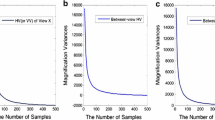Abstract
In this paper, a novel LDA-based dimensionality reduction method called fractional-order embedding direct LDA (FEDLDA) is proposed. More specifically, we redefine the fractional-order between-class and within-class scatter matrices which can significantly reduce the deviation of sample covariance matrices caused by the noise disturbance and limited number of training samples; then the novel feature extraction criterion based on the direct LDA (DLDA) and the idea of fractional-order embedding is applied. Experiments on AT&T, Yale and AR face image databases are performed to test and evaluate the effectiveness of the proposed algorithms. Extensive experimental results show that FEDLDA outperforms DLDA and other closely related methods in terms of classification accuracy and efficiency.










Similar content being viewed by others
Explore related subjects
Discover the latest articles and news from researchers in related subjects, suggested using machine learning.References
Cao B, Shen D, Sun JT, Yang Q, Chen Z (2007) Feature selection in a kernel space. In: International conference on machine learning (ICML) Oregon, USA, pp 121–128
Truk M, Pentland A (1991) Eigenfaces for recognition. J Cognit Neurosci 3(1):71–86
Fukunaga K (1990) Introduction to statistical pattern classification. Academic Press, San Diego
Shashua A (1999) On the relationship between the support vector machine for classification and sparsified Fisher’s linear discriminant. Neural Process Lett 9(2):129–139
Sharma A, Kuldip KK (2008) A gradient linear discriminant analysis for small sample sized problem. Neural Process Lett 27(1):17–24
Tao D, Li X, Wu X et al (2009) Geometric mean for subspace selection. IEEE Trans Pattern Anal Mach Intell 31(2):260–274
Sugiyama M (2006) Local Fisher discriminant analysis for supervised dimensionality reduction. In: Proceedings of the 23rd international conference on machine learning, AMC Press
Yang J, Yang JY, Frangi AF (2003) Combined Fisherfaces framework. Image Vis Comput 21(12):1037–1044
Park CH, Park H (2008) A comparision of generalized linear discriminant analysis algorithms. Pattern Recognit 41:1083–1097
Howland P, Park H (2004) Generalizing discriminant analysis using the generalized singular value decomposition. IEEE Trans Pattern Anal Mach Intell 26(8):995–1006
Howland P, Jeon M, Park H (2003) Structure preserving dimension reduction for clustered text data based on the generalized singular value decomposition. SIAM J Matrix Anal Appl 25(1):165–179
Chen L, Liao HM, Ko M, Lin J, Yu G (2000) A new LDA-based face recognition system which can solve the small sample size problem. Pattern Recognit 33:1713–1726
Ye JP, Xiong T (2006) Computational and theoretical analysis of null space and orthogonal linear discriminant analysis. J Mach Learn Res 7:1183–1204
Ye J, Janardan R, Li Q, Park H (2004a) Feature extraction via generalized uncorrelated linear discriminant analysis. In: Proceedings of international conference on machine learning, pp 895–902
Friedman JH (1989) Regularized discriminant analysis. J Am Stat Assoc 84(405):165–175
Bosaghzadeh A, Moujahid A, Dornaika F (2013) Parameterless local discriminant embedding. Neural Process Lett 38(1):53–67
Song D, Tao D (2009) Discriminative geometry preserving projections. In: 16th IEEE international conference on image processing (ICIP), pp 2457–2460
Zhang T, Tao D, Yang J (2008) Discriminative locality alignment. In: European conference on computer vision. Springer, Berlin, pp 725–738
Zhang L, Zhang L, Tao D et al (2013) Tensor discriminative locality alignment for hyperspectral image spectral-spatial feature extraction. IEEE Trans Geosci Remote Sens 51(1):242–256
Hendrikse A, Spreeuwers L, Veldhuis R (2009) A bootstrap approach to eigenvalue correction. In: Proceedings of the 2009 ninth IEEE international conference on data mining, pp 818–823
Yuan Y-H, Sun Q-S (2013) Fractional-order embedding multiset canonical correlations with applications to multi-faeture fusion and recognition. Neurocomputing 122:229–238
Yuan Y-H, Sun Q-S, Ge H-W (2014) Fractional-order embedding canonical correlation analysis and its applications to multi-view dimensionality reduction and recognition. Pattern Recognit 47:1411–1424
Pu Y-F, Zhou J-L, Yuan X (2010) Fractional differential mask: a fractional differential-based approach for multiscale texture enhancement. IEEE Trans Image Process 19(2):491–511
Pan W, Qin K, Chen Y (2009) An adaptable-multilayer fractional Fourier transform approach for image registration. IEEE Trans Pattern Anal Mach Intell 31(3):400–413
Liu J, Chen S, Tan X (2008) Fractional order singular value decomposition representation for face recognition. Pattern Recognit 41(1):378–395
Yu H, Yang J (2001) A direct LDA algorithm for high-dimensional data-with application to face recognition. Pattern Recognit 34:2067–2070
Hendrikse A, Veldhuis R, Spreeuwers L (2008) Eigenvalue correction results in face recognition. In: Proceedings of the 29th symposium on information theory in the Benelux, pp 27–35
Xu P, Brock GN, Parrish RS (2009) Modified linear discriminant analysis approaches for classification of high-dimensional microarray data. Comput Stat Data Anal 53(5):1674–1687
Ji H, Sun Q, Xiao S, Ji Z (2017) Fractional-order embedding supervised canonical correlations analysis with applications to feature extraction and recognition. Neural Process Lett 45(1):279–297
Yang J, Fan LY (2014) A novel indefinite kernel dimensionality reduction algorithm: weighted generalized indefinite kernel discriminant analysis. Neural Process Lett 40(3):301–313
Lu G, Wang Y, Zou J (2011) Graph maximum margin criterion for face recognition. Neural Process Lett 44(2):387–405
Acknowledgements
This work is supported by National Natural Science Foundation of China (61673220).
Author information
Authors and Affiliations
Corresponding author
Rights and permissions
About this article
Cite this article
Yang, J., Sun, QS. & Yuan, YH. Feature Extraction Using Fractional-Order Embedding Direct Linear Discriminant Analysis. Neural Process Lett 48, 1583–1595 (2018). https://doi.org/10.1007/s11063-018-9780-1
Published:
Issue Date:
DOI: https://doi.org/10.1007/s11063-018-9780-1




